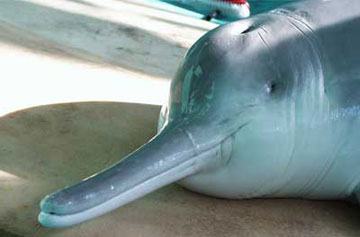“Extinct” baiji river dolphin spotted alive in China
“Extinct” baiji river dolphin spotted alive in China
mongabay.com
August 29, 2007
An “extinct” baiji has been spotted alive in the Yangtze River, reports Chinese state media.
The freshwater dolphin, declared extinct just days ago by a leading Chinese scientist, was seen at Xuba ferry in Tongling (Anhui Province) on August 19 and filmed it with a digital camera, said Dr. Wang Kexiong, a researcher at the Institute of Hydrobiology of the Chinese Academy of Sciences who reviewed the video footage.
“We are very glad to see baiji still exist in the world,” Wang was quoted as saying by Xinhua.
The news comes shortly after China’s leading expert on the baiji, Wang Ding, pronounced the species extinct following a fruitless 38-day search of the Yangtze by an international team of scientists.
 The Baiji or Yangtze River Dolphin. Photo by Wang Ding and courtesy of the Institute of Hydrobiology, Chinese Academy of Sciences. |
At the time expedition members said that a few Baiji may still exist in the murky waters of the Yangtze but that the population is no longer viable and any stragglers will die out within a generation. In other words, the reprieve will likely be short-lived.
“We have to accept the fact, that the Baiji is functionally extinct. It is a tragedy, a loss not only for China, but for the entire world,” said August Pfluger, a noted Baiji expert and head of baiji.org, a group that seeks to protect the dolphin.
The Chinese government has said it will try to capture any remaining baiji for a captive breeding program.
The baiji’s demise
The ultimate demise of the Baiji was caused by pollution, overfishing, boat traffic, and obstructions like dams. Unusually, the dolphin’s decline was not tied to direct harvesting by humans.
 The Baiji or Yangtze River Dolphin. Photo by Wang Ding and courtesy of the Institute of Hydrobiology, Chinese Academy of Sciences. |
When the Baiji is officially declared extinct by the International Union for the Conservation of Nature / World Conservation Union (IUCN) — 50 years after its last recorded sighting — it will be first large aquatic mammal to disappear since the Caribbean monk seal in the 1950s. Chinese rivers still support a population of freshwater cetaceans: the endemic Yangtze Finless Porpoise. However, the Baiji survey found less than 400.
“Their numbers are declining at an alarming rate. If we do not act soon they will become a second Baiji”, said Wang Ding, deputy director of the Institute of Hydrobiology of the Chinese Academy of Science in Wuhan.
“The loss of such a unique and charismatic species is a shocking tragedy. The Yangtze River dolphin was a remarkable mammal that separated from all other species over twenty million years ago. This extinction represents the disappearance of a complete branch of the evolutionary tree of life and emphasizes that we have yet to take full responsibility in our role as guardians of the planet,” said Dr Sam Turvey of the Zoological Society of London and a participant in the six-week search for baiji. “The baiji’s extinction also highlights the need for new conservation initiatives in China’s increasingly threatened Yangtze ecosystem, which is also home to endangered freshwater porpoises, seven-metre long fish, giant salamanders and white Siberian cranes.”







